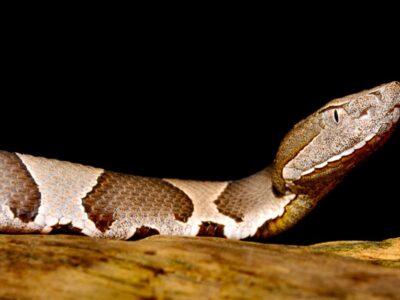Arkansas is a southern state with a population of about 3 million. It borders Texas and Oklahoma to the east, Louisiana to the south, and Mississippi and Tennessee to the west.
Arkansas calls itself “the Natural State,” and it’s easy to see why. Bordered by the Ozark Mountains on one side and the Ouachita Mountains on another, it has breathtaking mountain vistas, deep valleys, and rushing mountain streams. Arkansas has densely forested timberlands and fertile lowlands known for their rich black soil. The lower part of the state is on the Mississippi Delta and the Gulf of Mexico, and its wetlands include cypress swamps, headwater swamps, and slope wetlands.
Although its weather is often described as subtropical, Arkansas has four distinct seasons. It has hot, humid summers, cool falls, dry springs, and snowy winters.
Wild Animals in Arkansas

Eastern spotted skunks are native to Arkansas.
©Holly Kuchera/Shutterstock.com
The state’s low population density, varied topography, and wild landscapes have allowed many native species to thrive here. Arkansas’s mountains and forests are excellent places to see birds and wildlife. There are 400 native bird species and more than 150 butterfly and moth species. You can spot great blue herons, snowy owls, ruby-throated hummingbirds, white ibis, golden-crowned kinglets, and four species of oriole. Arkansas is home to the red-cockaded woodpecker, one of the rarest endangered birds.
Arkansas has 16 native bat species, including the endangered Rafinesque’s big-eared bat, the hoary bat, and the Seminole bat. Many of its animals include mammals and rodents common to most forested states.
Arkansas’s predators include coyotes, gray foxes, red foxes, and bobcats. Among its rodents are 12 mouse species, ground squirrels, and the southern flying squirrel. Its small mammals include river otters, shrews, pocket gophers, cottontail rabbits, and opossums.
Arkansas has some strange mammals like the nine-banded armadillo and the eastern woodrat. It also has strange rodents you will only find here, like the thirteen-lined ground squirrel, the southern bog lemming, and the Texas deer mouse.
The state is home to two species of skunk, the eastern spotted skunk and the striped skunk, and several shrew species.
Reptiles and amphibians include the most common types, but they also include some weird species like prairie lizards, Texas horned lizards, bull snakes, eastern garter snakes, and Gulf crayfish. Arkansas also has alligators, turtles, and geckos.
Elk were once hunted to extinction, but conservation efforts have reintroduced them to the area surrounding the Buffalo National River in northwest Arkansas. Black bears have also returned to the state after years of absence.
The Official Animal of Arkansas
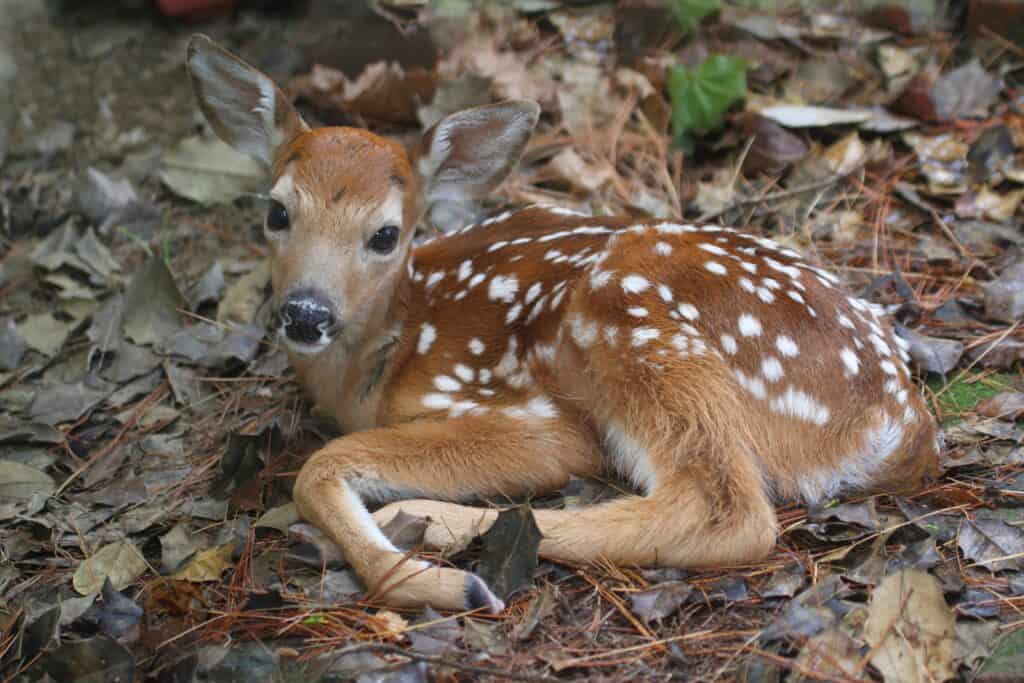
White-tailed deer are the state animal of Arkansas.
©Steve Byland/Shutterstock.com
The white-tail deer is the official animal of Arkansas, and it can be found in abundance throughout the state. Hunting game such as deer plays an important role in the local economy, and elk are also a popular choice for hunters.
The mockingbird is the state bird, with its melodic chirping bringing joy to many Arkansans. As well as being home to these animals, Arkansas has some beautiful flora too. The state tree is the pine tree. This majestic evergreen symbolizes both strength and longevity, qualities that are shared by all who call this wonderful state home!
Where To Find the Top Wild Animals in Arkansas

Mount Magazine State Park is one of many wonderful places to see nature and wild animals.
©Stephan Hawks/Shutterstock.com
Arkansas is home to many wildlife preserves and nature walks that provide visitors with opportunities to observe wild animals in their natural habitats. Places like these are beneficial for a variety of reasons.
For example, they are important for research and conservation as scientists can monitor the health of species or measure how well certain populations are doing in different areas. They also help protect endangered species from illegal poaching or development activities that could harm their habitat.
Nature walks allow people to appreciate natural beauty while learning more about local flora and fauna, which helps increase awareness of environmental issues. Finally, sanctuaries provide refuge for animals who have been injured or abused by humans, giving them the chance to heal without fear of further danger. All in all, places like this have an incredibly positive impact on both human society and the environment!
- Pinnacle Mountain State Park is a large state park that is also a Trail of Tears National Historic Site. It has 15 miles of hiking and biking trails and river walks. It is an excellent place to see some of the state’s rarest butterflies, moths, and birds.
- The Delta Rivers Nature Center, established in 2001, was the state’s first nature center. It displays fish and aquatic animals in a natural setting that duplicates river bottom habitats.
- Hot Springs National Park includes 47 natural thermal springs, 30 miles of hiking trails, and a hot water cascade. It is one of the best places to camp in Arkansas and an excellent place to view wildlife and birds.
- Lake Chicot State Park is a protected area surrounding the 20-mile-long Lake Chicot, the largest natural lake in the state.
- Turpentine Creek Wildlife Refuge is a 459-acre sanctuary for abused and abandoned big cats. The refuge is accredited by the Global Federation of Animal Sanctuaries as an ethical animal tourism destination.
Biggest Animals in Arkansas
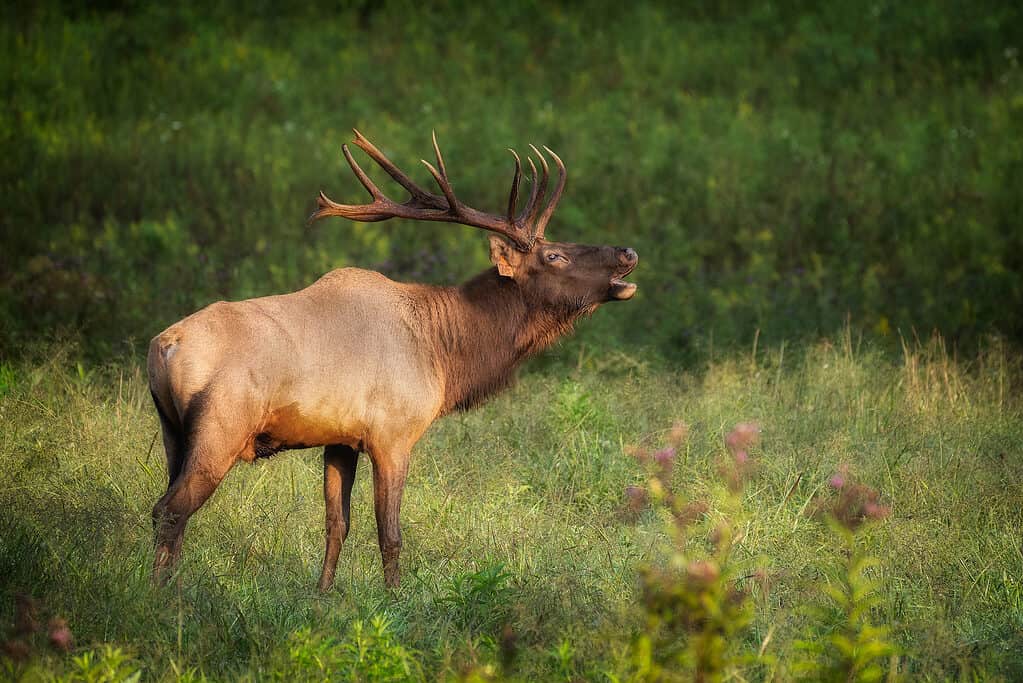
A Rocky Mountain elk is one of the largest animals in Arkansas
©iStock.com/MattCuda
The largest animals in Arkansas are the American black bear, white-tailed deer, and wild turkey. These animals can reach impressive sizes due to the abundance of food sources available in the natural habitats they call home.
American black bears have an average weight of between 130 and 500 pounds when fully grown. They prefer forested areas near streams or rivers that provide plenty of plants to eat as well as a reliable source of water. Bears will also scavenge for human food if given the chance, so it’s important to keep trash cans secure where these animals live!
White-tailed deer are some of the most recognizable wildlife species in Arkansas, with their characteristic reddish coats and large antlers on males during the breeding season. Adults range from 90-250 pounds depending on age, gender, and nutrition availability. Deer inhabit both open fields and woodlands but prefer dense cover like thick brush or trees for protection from predators.
Elk are also found in Arkansas, ranging in size from 500 to 700 pounds! Additionally, wild boars have recently been reintroduced into some areas of Arkansas, reaching weights of up to 600 pounds. While these animals may not be incredibly common due to habitat loss or hunting pressures, they still make their presence known as a reminder of just how much diversity exists within this great state’s wildlife!
3 Rarest Animals in Arkansas

Bald Eagles are one of the rarest animals to spot in Arkansas.
©Jon C. Beverly/Shutterstock.com
In Arkansas, several animals can be considered rare but not endangered. These include black bears, wild boars, and bald eagles. Black bears inhabit wooded areas with plenty of food sources, such as acorns and berries. They also prefer to live in forests with thick vegetation for cover.
Wild boars are found in the Ozark Mountains and tend to congregate near wetlands or streams, where they feed on aquatic plants and grasses.
Bald eagles can be seen along rivers or lakes where they will build their nests high up in tall trees or cliffs so that they can soar above the landscape looking for prey such as fish or small mammals.
The Most Dangerous Animals in Arkansas Today

Brown recluse spiders are one of the most dangerous creatures in Arkansas
©iStock.com/StephenFB
Some Arkansans joke that the most dangerous animals in their state are careless, armed game hunters. Jokes aside, Arkansas has some dangerous animals, including alligators and bears, but attacks on humans are rare. The most dangerous animals to humans are the state’s poisonous snakes and spiders.
Snakes: Arkansas has copperhead snakes, timber rattlesnakes, and the western banded rattlesnake.
Spiders: Arkansas is home to the venomous brown recluse spider.
Endangered Animals in Arkansas
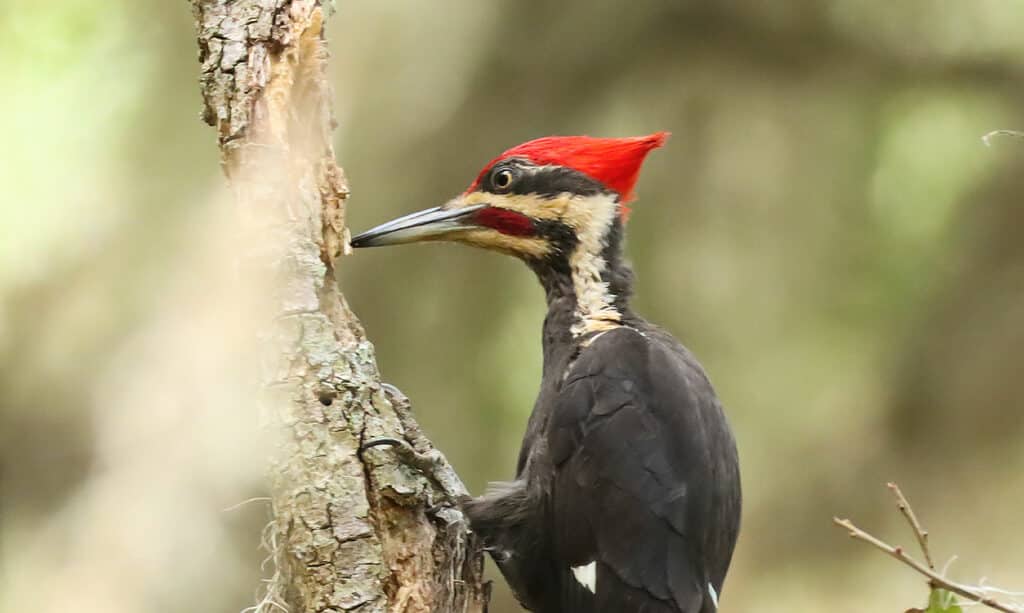
The ivory-billed woodpecker is an endangered species found in Arkansas.
©iStock.com/Wirestock
Animals in Arkansas are becoming endangered due to a variety of factors, such as habitat destruction and fragmentation, poaching, pollution, and climate change. The loss of natural habitats from development projects or farming activities can drastically reduce the amount of available space for animals.
Poaching is another major contributor when illegal hunters take too many animals for their own consumption or for sale on the black market. Pollution can also be dangerous to wildlife populations as it contaminates their food sources or destroys their habitats. Finally, climate change has been causing extreme weather events that have killed off entire species in Arkansas.
Arkansas has 32 threatened and endangered species. They include:
- Ozark big-eared bat (Corynorhinus tonswendii ingens)
- Ozark cave fish (Troglichthys rosae)
- Ozark hellbender (Crypotbranchus alleganiensis bishop)
- Curtis pearly mussel (Epioblasma curtisi)
- Ivory-billed woodpecker (Campephilus principalis)
- Rattlesnake-master borer moth (Papaipema eryngi)
The Ozark hellbender is a strange animal with an equally weird name. One of the rarest species, this endangered salamander only lives in the mountain streams of the Ozarks. The states of Missouri and Arkansas are working together to preserve the hellbender.
The rattlesnake-master borer moth is one of the rarest moths. It exists in only five states, including Arkansas, Illinois, Kentucky, North Carolina, and Oklahoma. The moth gets its strange name from its dependence on the rattlesnake master, a prairie plant that is its only food source.
Arkansas residents can help protect these endangered species by supporting conservation efforts that focus on protecting animal habitats and restoring areas back to health where possible. This includes reducing plastic waste and other pollutants that damage the environment. Additionally, individuals should report any suspicious activity related to poaching so that law enforcement officers can investigate further if necessary. Finally, people should consider donating money or volunteering their time at local conservation organizations that work hard every day to preserve our state’s precious wildlife resources!
Native Plants in Arkansas

Dogwood trees are one of many plants native to Arkansas.
©Virunja/Shutterstock.com
Arkansas is home to a diverse array of evergreen and deciduous plant species. With over 11.7 billion trees covering around 56% of the state, you are bound to come across the silver or boxelder maple trees, which just happen to be indigenous to Arkansas.
In addition to the silver and boxelder maple trees, Arkansas is home to an array of native wildflowers. These include the fragrant white-flowering dogwood tree, the yellow-blooming Indian blanket flower, and the pink iris.
The state also has a variety of flowering shrubs, such as rhododendron and mountain laurels, that can be seen blooming in springtime. In addition, several species of ferns are native to Arkansas, including sensitive ferns, bracken ferns, Christmas ferns, ostrich ferns, and hay-scented ferns. With so many different types of plants throughout the state, you will never be short on beauty while exploring nature in Arkansas!
The Flag of Arkansas

The Arkansas flag has a lot of symbolic meaning.
©iStock.com/rarrarorro
Arkansas’ flag is a distinct symbol of the state. It features a red background, commonly referred to as “the field,” which is charged with a large white diamond in the center. The diamond has blue borders that contain 25 five-pointed stars and four other stars located inside the diamond itself. In addition, within the white diamond is written in blue letters; “Arkansas.”
The symbolism behind this flag is significant for Arkansas residents. The twenty-five stars represent Arkansas being admitted into the Union as the 25th state on June 15th, 1836, while each of those four additional stars signifies subsequent admittance of states after Arkansas joined the union up until 1861 when it seceded from it during Civil War times.
Two colors are featured heavily throughout represent opposing sides. Red signifies its people’s loyalty to their Confederate cause and loyalty whilst blue stands for their perseverance and faithfulness towards America’s Union principles.
More Articles Related to Arkansas
Read about:
- extinct animals that lived in Arkansas.
- the amazing waterfalls in Arkansas.
- the best fishing spots in Arkansas this summer.
- the best national parks in Arkansas.
- the types of hawks in Arkansas.
Arkansan Animals

Admiral Butterfly
Stunningly beautiful wings
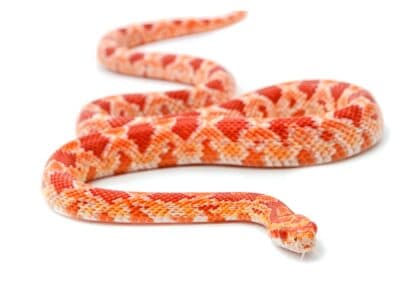
Albino (Amelanistic) Corn Snake
Albino corn snakes make great beginner snakes.
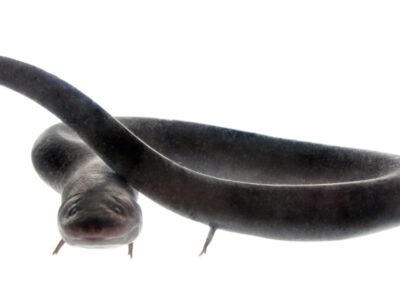
American Eel
Don't eat raw eel! Their blood is poisonous to humans when consumed raw.

Armyworm
They are so named because they "march" in armies of worms from one crop to another in search of food
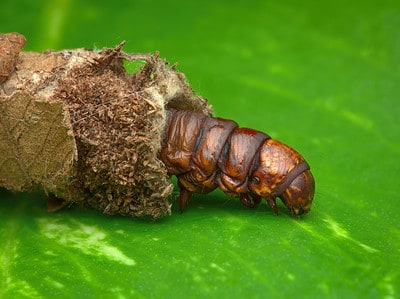
Bagworm Moth Caterpillar
They continually enlarge their protective cases

Banded Water Snake
Some water snakes defend themselves violently.

Beewolf wasp
They hunt bees

Common Yellowthroat
The Common Yellowthroat stays close to the ground and uses stealth to survive!
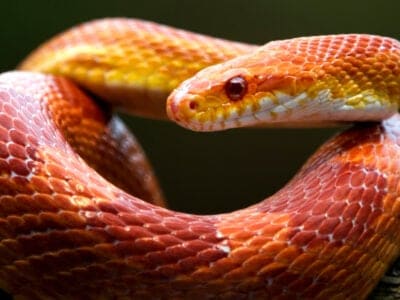
Corn Snake
Corn snakes are partly arboreal and are excellent climbers.

Crocodylomorph
Crocodylomorphs include extinct ancient species as well as 26 living species today.
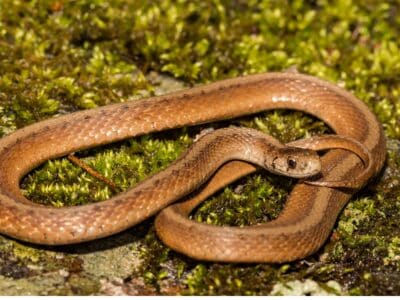
De Kay’s Brown Snake
They have specialized jaws for removing snails from shells.
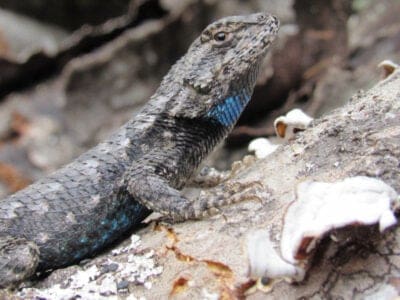
Eastern Fence Lizard
Females are usually larger than males.
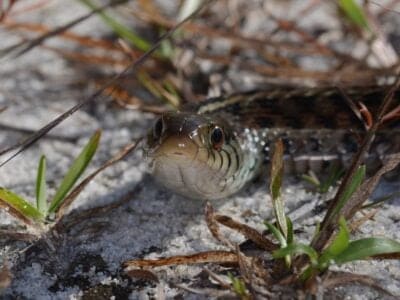
Eastern Glass Lizard
When the glass lizard loses its tail it can grow another one. But the new tail lacks the markings of the old one and is usually shorter.

Eastern Hognose Snake
Eastern hognose snakes are venomous, but only to frogs and toads.
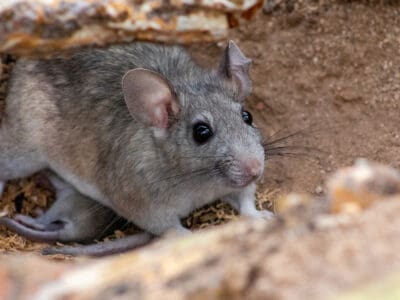
Eastern Woodrat
The eastern woodrat mating ritual involves a potentially deadly fight between the male and female before reproduction begins!

Flea
Adult fleas can jump up to 7 inches in the air
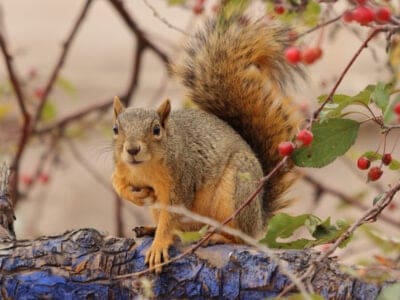
Fox Squirrel
Although it is a tree squirrel, it spends most of its time on the ground.
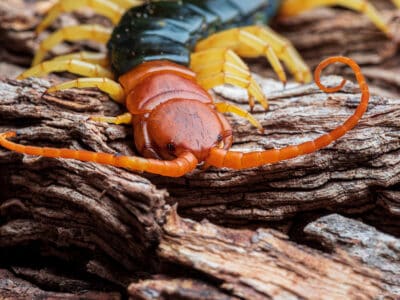
Giant Desert Centipede
They are the largest centipede in North America

Groundhog (Woodchuck)
They whistle to each other to warn of approaching danger!

Jackrabbit
They can run as fast as 45 mph.

Kentucky Warbler
The Kentucky Warbler appears to wear bright yellow cat-eye glasses!

Mealybug
They have a symbiotic relationship with ants.

Mockingbird
Mockingbirds are incredible mimics that can learn hundreds of songs!
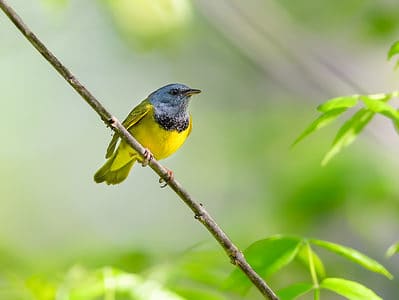
Mourning Warbler
The Mourning Warbler was named for its gray head, which resembles a mourning veil!

Nematode
Nematodes range in size from 1/10 of an inch to 28 feet long

Orb Weaver
Females are about four times the size of males

Owl
The owl can rotate its head some 270 degrees
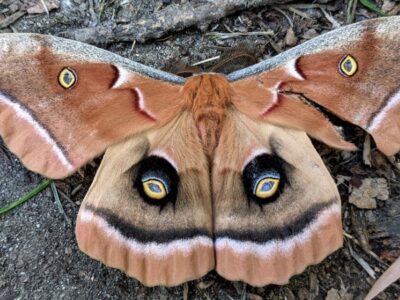
Polyphemus Moth
The Polyphemus moth doesn’t and can't eat, except when it's a caterpillar!

Pygmy Rattlesnake
Pygmy rattlesnakes’ rattle is so small it can only be heard from about three feet away.
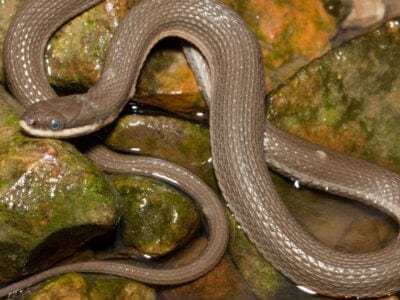
Queen Snake
Queen snakes have armor-like scales on the top of their head
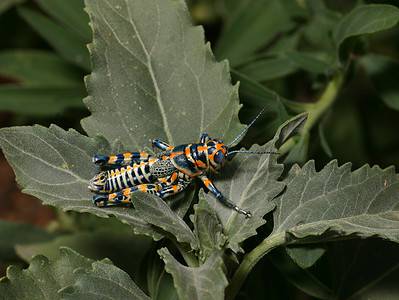
Rainbow Grasshopper (Dactylotum bicolor)
They have strikingly bright colors

Rat Snakes
Rat snakes are constrictors from the Colubridae family of snakes.

Red-Bellied Woodpecker
Red-Bellied Woodpeckers will often steal the nests of other birds.
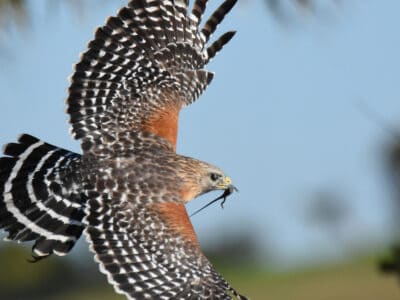
Red-Shouldered Hawk
Red-Shouldered Hawks reuse the same nesting area each year.

Rooster
Will mate with the entire flock!

Rough Earth Snake
It has a pointed snout that is uses to burrow into moist soil.
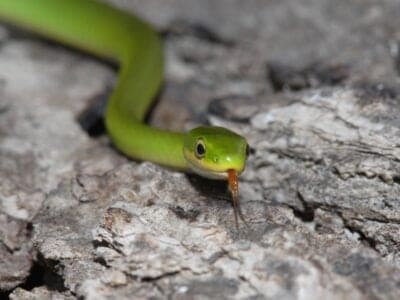
Rough Green Snake
Rough green snakes are great pet snakes because they're low-maintenance.

Smallmouth Bass
A fierce fighter!

Smokybrown Cockroach
Has up to 45 eggs per egg case

Southern Black Racer
These snakes live underground, beneath piles of leaf litter or in thickets, and they are expert swimmers.
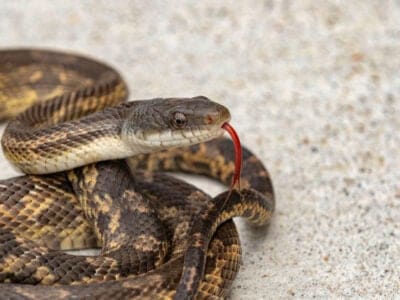
Texas Rat Snake
The Texas rat snake is one of the most common subspecies of the western rat snake in the wild.

Tree Cricket
They make music with their wings

Western Diamondback Rattlesnake
They replace their fangs 2-4 times per year!

Western Rat Snake
Western rat snakes have special scales on their belly that help them climb up trees.
Arkansan Animals List
- Admiral Butterfly
- Agkistrodon Contortrix
- Albino (Amelanistic) Corn Snake
- American Eel
- Armyworm
- Bagworm Moth Caterpillar
- Banded Water Snake
- Beewolf wasp
- Common Yellowthroat
- Corn Snake
- Crocodylomorph
- De Kay’s Brown Snake
- Eastern Fence Lizard
- Eastern Glass Lizard
- Eastern Hognose Snake
- Eastern Woodrat
- Flea
- Fox Squirrel
- Giant Desert Centipede
- Groundhog (Woodchuck)
- Jackrabbit
- Kentucky Warbler
- Mealybug
- Milk Snake
- Mockingbird
- Mourning Warbler
- Nematode
- Orb Weaver
- Owl
- Polyphemus Moth
- Pygmy Rattlesnake
- Queen Snake
- Rainbow Grasshopper (Dactylotum bicolor)
- Rat Snakes
- Red-Bellied Woodpecker
- Red-Shouldered Hawk
- Rooster
- Rough Earth Snake
- Rough Green Snake
- Smallmouth Bass
- Smokybrown Cockroach
- Southern Black Racer
- Swallowtail Butterfly
- Texas Rat Snake
- Tree Cricket
- Western Diamondback Rattlesnake
- Western Rat Snake
Animals in Arkansas FAQs (Frequently Asked Questions)
What animal is Arkansas known for?
Arkansas was once nicknamed “the Bear State,” but black bears almost became extinct from overhunting. Today, black bears have been successfully reintroduced and have a stable population in the state.
What animal predators are in Arkansas?
Arkansas’s biggest predators are alligators, wolves and bobcats.
What is the largest animal in Arkansas?
Alligators, elks and black bears are the biggest animals in the state.
What animals are in northwest Arkansas?
Elk are the main animals you’ll see in northwest Arkansas. They live mostly along the Buffalo National River, and you can see large herds of these magnificent animals grazing there.
The Boxley Valley has a large mill pond that is home to water turtles and trumpet swans. Big Piney Wildlife Management Area is home to bald eagles and other rare birds.



